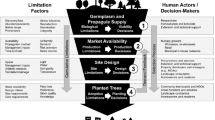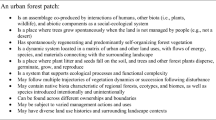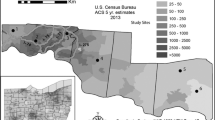Abstract
Urban forests have garnered increasing attention as providers of an array of beneficial ecosystem services. However, urban forest ecosystems are highly complex and heterogeneous systems whose structure are shaped by interacting social and ecological processes. Approaches to reliably identify and differentiate these processes could be valuable for addressing complexity and reducing uncertainty in decision-making in urban forestry. The purpose of this study is to identify and quantify a range of social and ecological drivers of urban forest species composition, distribution, and diversity. This was done using hierarchical cluster analysis and discriminant analysis with empirical plot data describing the tree species composition in Toronto, Canada. Tree density and imperviousness were by far the most influential drivers of species composition. Increasing imperviousness saw not just reduced tree density but a decline in native species abundance. Additionally, single-detached housing, homeownership, and income were closely associated and explained higher tree densities and abundances of native species. However, income had a lower than expected influence on urban forest species composition given its importance in canopy cover research. Continuous forest patches were highly distinct compared to the remainder of the urban landscape, which highlights the ecological distinctiveness of residual forests within cities and lends support to their conservation. Increasing the understanding of social and ecological drivers of tree species composition, distribution, and diversity within cities is an integral part of urban forest ecosystem classification, which can be a valuable decision-support tool for ecosystem-based management in urban forestry.





Similar content being viewed by others
References
Avolio ML, Pataki DE, Pincetl S, Gillespie TW, Jenerette GD, McCarthy HR (2015) Understanding preferences for tree attributes: the relative effects of socio-economic and local environmental factors. Urban Ecosyst 18:73–86
Bailey RG (2009) Ecosystem geography: from ecoregions to sites, 2nd edn. Springer, New York
Boone CG, Cadenasso ML, Grove JM, Schwarz K, Buckley GL (2010) Landscape, vegetation characteristics, and group identity in an urban and suburban watershed: why the 60s matter. Urban Ecosyst 13:255–271
Bourne KS, Conway TM (2014) The influence of land use type and municipal context on urban tree species diversity. Urban Ecosyst 17:329–348
Brady RF, Tobias T, Eagles PJF, Ohrner R, Micak J, Veale B, Dorney RS (1979) A typology for the urban ecosystem and its relationship to larger biogeographical landscape units. Urban Ecol 4:11–28
Burns RM, Honkala BH (1990) Silvics of North America: 1. Conifers; 2. Hardwoods. Washington, DC, United States Department of Agriculture Forest Service
Call LJ, Nilsen ET (2003) Analysis of spatial patterns and spatial association between the invasive tree-of-heaven (Ailanthus altissima) and the native black locust (Robinia pseudoacacia). Am Midl Nat 150:1–14
Cao Y, Larsen DP, Thorne RSJ (2001) Rare species in multivariate analysis for bioassessment: some considerations. J N Am Benthol Soc 20:144–153
City of Toronto (2010) Every tree counts: A portrait of Toronto’s urban forest. http://www1.toronto.ca/staticfiles/City%20Of%20Toronto/Parks%20Forestry%20&%20Recreation/Urban%20Forestry/Files/pdf/E/every_tree_counts.pdf. Accessed 12 June 2017
Conway TM (2016) Tending their urban forest: residents’ motivations for tree planting and removal. Urban For Urban Greening 17:23–32
Conway TM, Bourne KS (2013) A comparison of neighborhood characteristics related to canopy cover, stem density and species richness in an urban forest. Landsc Urban Plan 113:10–18
Conway TM, Vander Vecht J (2015) Growing a diverse urban forest: species selection decisions by practitioners planting and supplying trees. Landsc Urban Plan 138:1–10
Dorney JR, Guntenspergen GR, Keough JR, Stearns F (1984) Composition and structure of an urban woody plant community. Urban Ecol 8(1–2):69–90
Duinker PN, Ordóñez C, Steenberg JWN, Miller KH, Toni SA, Nitoslawski SA (2015) Trees in Canadian cities: indispensable life form for urban sustainability. Sustainability 7:7379–7396
Environment Canada (2015) Canadian climate normal: 1981–2010 climate normals & averages. http://climate.weather.gc.ca/climate_normals/index_e.html. Accessed 12 June 2017
Farrar JL (1995) Trees in Canada. Markham, Canadian Forest Service and Fitzhenry & Whiteside Ltd
Foster J, Sandberg LA (2004) Friends or foe? Invasive species and public green spaces in Toronto. Geogr Rev 94:178–198
Fraser ED, Kenney WA (2000) Cultural background and landscape history as factors affecting perceptions of the urban forest. J Arboric 26:106–113
Greene CS, Millward AA (2016) The legacy of past tree planting decisions for a city confronting emerald ash borer (Agrilus planipennis) invasion. Front Ecol Evol 4:1–12
Greene CS, Millward AA, Ceh B (2011) Who is likely to plant a tree? The use of public socio-demographic data to characterize client participants in a private urban forestation program. Urban For Urban Green 10:29–38
Grimm NB, Grove JM, Pickett STA, Redman CL (2000) Integrated approaches to long-term studies of urban ecological systems. Bioscience 50:571–584
Grove JM, Troy AR, O’Neil-Dunne JPM, Burch WR, Cadenasso ML, Pickett STA (2006) Characterization of households and its implications for the vegetation of urban ecosystems. Ecosystems 9:578–597
Grove JM, Locke DH, O’Neil-Dunne JPM (2014) An ecology of prestige in new York City: examining the relationships among population density, socio-economic status, group identity, and residential canopy cover. Environ Manag 54:402–419
Grumbine RE (1994) What is ecosystem management? Conserv Biol 8:27–38
Hamann A, Wang T (2006) Potential effects of climate change on ecosystem and tree species distribution in British Columbia. Ecol 87:2773–2786
Hargrove WW, Hoffman FM (2005) Potential of multivariate quantitative methods for delineation and visualization of ecoregions. Environ Manag 34:S39–S60
Heynen NC, Lindsey G (2003) Correlates of urban forest canopy cover: implications for local public works. Public Works Manage Policy 8:33–47
Heynen N, Perkins HA, Roy P (2006) The political ecology of uneven urban green space the impact of political economy on race and ethnicity in producing environmental inequality in Milwaukee. Urban Aff Rev 42:3–25
Jongman RHG, Ter Braak CJF, Van Tongeren OFR (1995) Data analysis in community and landscape ecology. Cambridge University Press, Cambridge
Jutras P, Prasher SO, Mehuys GR (2010) Appraisal of key biotic parameters affecting street tree growth. J Arboric 36:1–10
Kendal D, Williams NSG, Williams KJH (2012) Drivers of diversity and tree cover in gardens, parks and streetscapes in an Australian city. Urban For Urban Green 11:257–265
Kenney WA, Idziak C (2000) The state of Canada’s municipal forests – 1996 to 1998. For Chron 76:231–235
Kenney WA, Van Wassenaer PJ, Satel AL (2011) Criteria and indicators for strategic urban forest planning and management. Arboricult Urban For 37:108–117
Klijn F, Udo de Haes HA (1994) A hierarchical approach to ecosystems and its implications for ecological land classification. Landsc Ecol 9:89–104
Ko Y, Lee JH, McPherson EG, Roman LA (2015) Factors affecting long-term mortality of residential shade trees: evidence from Sacramento, California. Urban For Urban Green 14:500–507
Laćan I, McBride JR (2008) Pest vulnerability matrix (PVM): a graphic model for assessing the interaction between tree species diversity and urban forest susceptibility to insects and diseases. Urban For Urban Green 7:291–300
Lu JWT, Svenden ES, Campbell LK, Greenfeld J, Braden J, King KL, Falxa-Raymond N (2010) Biological, social, and urban design factors affecting young tree mortality in new York City. Cities Environ (CATE) 3:1–15
Martin PH, Marks PL (2006) Intact forests provide only weak resistance to a shade-tolerant invasive Norway maple (Acer platanoides L.). J Ecol 94:1070–1079
Matthews ER, Peet RK, Weakley AS (2011) Classification and description of alluvial plant communities of the piedmont region, North Carolina, USA. Appl Veg Sci 14:485–505
Maxwell RS, Taylor AH, Skinner CN, Safford HD, Isaacs RE, Airey C, Young AB (2014) Landscape-scale modeling of reference period forest conditions and fire behavior on heavily logged lands. Ecosphere 5:1–28
McDonnell MJ, Pickett STA (1990) Ecosystem structure and function along urban-rural gradients: an unexploited opportunity for ecology. Ecol 71:1232–1237
McGarigal K, Cushman S, Stafford SG (2000) Multivariate statistics for wildlife and ecology research. Springer, New York
McKenney DW, Pedlar JH, Lawrence K, Campbell K, Hutchinson MF (2007) Potential impacts of climate change on the distribution of north American trees. Bioscience 57:939–948
McKinney ML (2008) Effects of urbanization on species richness: a review of plants and animals. Urban Ecosyst 11:161–176
McNab WH, Browning SA, Simon SA, Fouts PE (1999) An unconventional approach to ecosystem unit classification in western North Carolina, USA. For Ecol Manag 114:405–420
McPherson EG, Nowak D, Heisler G, Grimmond S, Souch C, Grant R, Rowntree R (1997) Quantifying urban forest structure, function, and value: the Chicago urban Forest climate project. Urban Ecosyst 1:49–61
Mora F, Iverson L (2002) A spatially constrained ecological classification: rationale, methodology, and implementation. Plant Ecol 158:153–169
Nitoslawski SA, Duinker PN, Bush PG (2016) A review of drivers of tree diversity in suburban areas: research needs for north American cities. Environ Rev 24:471–483
Nitoslawski SA, Steenberg JWN, Duinker PN, Bush PG (2017) Assessing the influence of location attributes on urban forest species composition in suburban neighbourhoods. Urban For Urban Greening 27:187-195
Nowak DJ, Dwyer JF (2007) Understanding the benefits and costs of urban forest ecosystems. In: Kuser JE (ed) Urban and community forestry in the northeast. New Brunswick, Springer, pp 25–46
Nowak DJ, Rowntree RA, McPherson EG, Sisinni SM, Kerkmann ER, Stevens JC (1996) Measuring and analyzing urban tree cover. Landsc Urban Plan 36:49–57
Nowak DJ, Kuroda M, Crane DE (2004) Tree mortality rates and tree population projections in Baltimore, Maryland, USA. Urban For Urban Green 2:139–147
Omernik JM (1987) Ecoregions of the conterminous United States. Ann Assoc Am Geogr 77:118–125
Ontario Ministry of Natural Resources (2012) Ontario’s forest regions: Deciduous forest. http://www.mnr.gov.on.ca/en/Business/Forests/2ColumnSubPage/STDPROD_091289.html. Accessed 12 June 2017
Ordóñez C, Duinker PN (2012) Ecological integrity in urban forests. Urban Ecosyst 15:863–877
Ordóñez C, Duinker PN (2013) An analysis of urban forest management plans in Canada: implications for urban forest management. Landsc Urban Plan 116:36–47
Pham T-T-H, Apparicio P, Landry S, Séguin A-M, Gagnon M (2013) Predictors of the distribution of street and backyard vegetation in Montreal, Canada. Urban For Urban Green 12:18–27
Pincetl S, Prabhu SS, Gillespie TW, Jenerette GD, Pataki DE (2013) The evolution of tree nursery offerings in Los Angeles County over the last 110 years. Landsc Urban Plan 118:10–17
Roman LA, McPherson EG, Scharenbroch BC, Bartens J (2013) Identifying common practices and challenges for local urban tree monitoring programs across the United States. Arboric Urban For 39:292–299
Schwarz K, Fragkias M, Boone CG, Zhou W, McHale M, Grove JM, O’Neil-Dunne J, McFadden JP, Buckley GL, Childers D, Ogden L, Pincetl S, Pataki D, Whitmer A, Cadenasso ML (2015) Trees grow on money: urban tree canopy cover and environmental justice. PLoS One 10:e0122051
Statistics Canada (2016) Census profile – Toronto. https://www12.statcan.gc.ca/census-recensement/2011/dp-pd/prof/details/page.cfm?Lang=E&Geo1=CSD&Code1=3520005&Geo2=PR&Code2=35&Data=Count&SearchText=Toronto&SearchType=Begins&SearchPR=01&B1=All&GeoLevel=PR&GeoCode=3520005. Accessed 12 June 2017
Stearns F, Montag T (1974) The urban ecosystem: a holistic approach. Stroudsburg, Dowden, Hutchinson, and Ross.
Steenberg JWN, Duinker PN, Charles JD (2013) The neighbourhood approach to urban forest management: the case of Halifax, Canada. Landsc Urban Plan 117:135–144
Steenberg JWN, Millward AA, Duinker PN, Nowak DJ, Robinson PJ (2015) Neighbourhood-scale urban forest ecosystem classification. J Environ Manag 163:134–145
Steenberg JWN, Millward AA, Nowak DJ, Robinson PJ (2017a) A conceptual framework of urban forest ecosystem vulnerability. Environ Rerv 25:115–126
Steenberg JWN, Robinson PJ, Millward AA (2017b) The influence of building renovation and rental housing on urban trees. J Environ Plan Manage 61:553-567
Toni SA, Duinker PN (2015) A framework for urban–woodland naturalization in Canada. Environ Rev 23:321–336
Trowbridge PJ, Bassuk NL (2004) Trees in the urban landscape. Wiley, Hoboken
Troy AR, Grove JM, O’Neil-Dunne JP, Pickett ST, Cadenasso ML (2007) Predicting opportunities for greening and patterns of vegetation on private urban lands. Environ Manag 40:394–412
Warren PS, Lerman SB, Charney ND (2008) Plants of a feather: spatial autocorrelation of gardening practices in suburban neighbourhoods. Biol Conserv 141:3–4
Womack B, Carter R (2011) Landscape scale forest community classification in the Horseback Mountain range of the Talladega National Forest, Alabama. Nat Areas J 31:51–64
Woodall CW, Nowak DJ, Liknes GC, Westfall JA (2010) Assessing the potential for urban trees to facilitate forest tree migration in the eastern United States. For Ecol Manag 259:1447–1454
Zhou Y, Narumalani S, Waltman WJ, Waltman SW, Palecki MA (2003) A GIS-based spatial pattern analysis model for eco-region mapping and characterization. Int J Geogr Inf Sci 17:445–462
Zipperer WC, Sissinni SM, Pouyat RV (1997) Urban tree cover: an ecological perspective. Urban Ecosyst 1:229–246
Zmyslony J, Gagnon D (2000) Path analysis of spatial predictors of front-yard landscape in an anthropogenic environment. Landsc Ecol 15:357–371
Acknowledgements
Funding for this research was provided by the Killam Trusts at Dalhousie University. Thank you to Dr. Peter Duinker and Dr. Christopher Greene at Dalhousie University for their review of the draft manuscript.
Author information
Authors and Affiliations
Corresponding author
Rights and permissions
About this article
Cite this article
Steenberg, J.W.N. People or place? An exploration of social and ecological drivers of urban forest species composition. Urban Ecosyst 21, 887–901 (2018). https://doi.org/10.1007/s11252-018-0764-8
Published:
Issue Date:
DOI: https://doi.org/10.1007/s11252-018-0764-8




